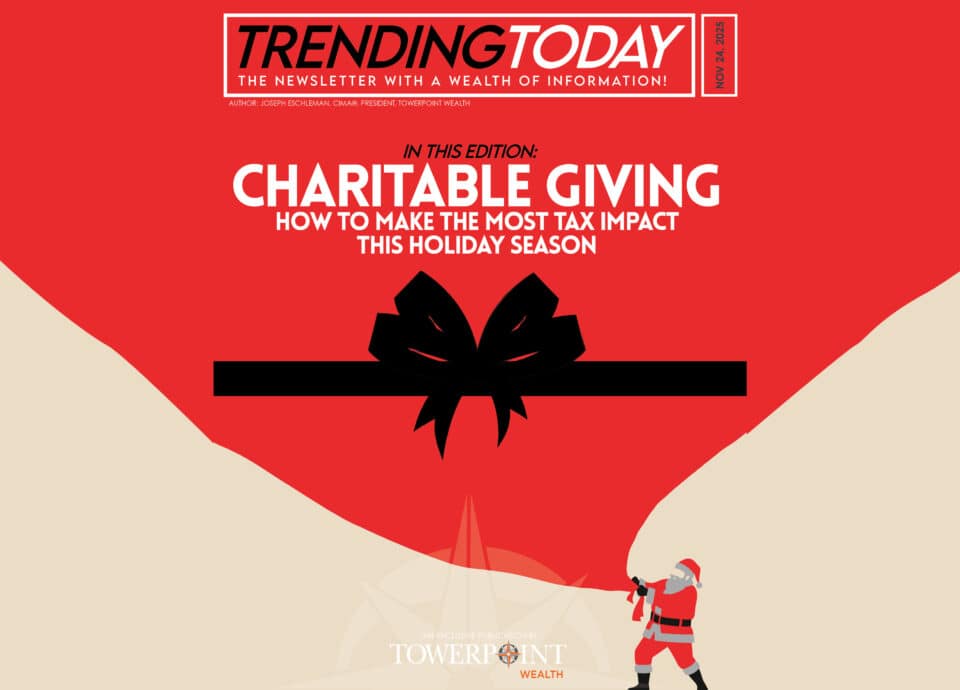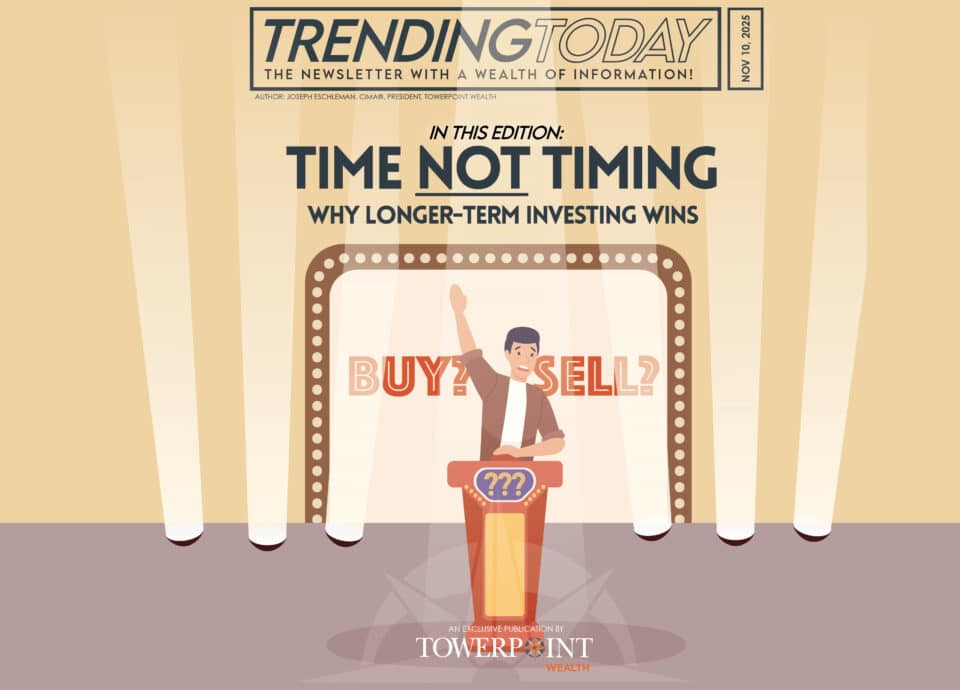“An Investment in Knowledge Pays the Best Interest” (Ben Franklin)
And I remember what she said to me
How she swore that it never would end
I remember how she held me oh so tight
Wish I didn’t know now what I didn’t know then
Against the wind
We were runnin’ against the wind
We were young and strong, we were runnin’
Against the wind…
(From “Against the Wind”, by Bob Seger & The Silver Bullet Band, 1980)
There is an old tongue-in-cheek market adage that says that portfolio managers are “never wrong, but sometimes they are early.” Well, in our case, that expression was flipped — We were exactly right, but late.
Back in July, we wrote the following:
…[W]e have entered a new phase of the market cycle, and we expect increased volatility and periodic bouts of investor panic as we move through the year, especially once the “dog days” of summer are over…
We then closed the July Commentary as follows:
[W]e expect a generally quiet period as we head into and through the heart of the summer. But while the risks may lie dormant due to general inattention, they certainly have not gone away. Enjoy the more relaxed market environment while you can – we suspect things will get “interesting” again once the summer months have passed…
So, we got “the call” correct but were “late” in expecting market volatility to stay subdued until after Labor Day. Instead, it exploded in late July and all the way through August.
August was a bad month for the equity markets (though an equally stupendous month for bonds). As we reach the final days of the month, US markets posted four consecutive weeks of negative performance and, depending on the market, were down between 3% and 7% for the month. To put this performance in better perspective, the YTD performances of all major equity markets are still positive (and the US markets in particular are still very positive). However, when looked at over the past twelve months, which includes the severe disruptions of Q4 2018, the heavy declines in May 2019, and the current downdraft of the past few weeks, we see a very different picture.
Over the past twelve months, every major global equity market has posted a flat-to-negative performance and, in the cases of the EAFE, EM, and US Small Cap markets, fairly severe negative performance. We believe it is safe to say that market volatility is once again alive and well.
Conversely, US Treasuries are on absolute tear, driven by a “flight to quality” and the fact that they still offer a positive (albeit small) yield, in comparison to the $17 trillion in negative yielding global debt. As we approach the end of the month, the 10+ year US Treasury index is flirting with a 10% return in August alone, and is up close to 22% for the year.
What is going on? For most of the past year, we have encouraged investors to focus on market signals versus market noise and, after a very “noisy” August, that advice still holds. We believe the drivers of recent market volatility fall into four broad categories:
- Trade tensions: The on-again / off-again trade negotiations between the US and China – now very off-again following a recent incredible “tweet rant” by President Trump – is beginning to have tangibly negative global economic effects. We remain reasonably optimistic that both sides will calm down and eventually settle, but it will take far longer than originally anticipated, and it may get worse before it gets better.
- Geopolitical anxiety: The most important issue on the geopolitical horizon remains uncertainty over “Brexit”. Upon becoming Prime Minister, Boris Johnson promised to bring “Brexit” to a successful conclusion, but it is not clear how he plans to – or can – pull that off. A “hard” exit – one where the UK simply leaves the European Union with no specific agreements in place regarding trade, immigration, labor mobility, and the issues regarding the internal Irish border (i.e., between Northern Ireland (part of the UK, and so “exiting”), and the Republic of Ireland (which will remain in the EU) – will have significant effects on the UK and European economies.
But “Brexit” is by no means the only geopolitical issue facing investors. The growing tension between Hong Kong and China, North Korea’s apparent “ramp up” in its nuclear activities (including the possible launch of a submarine capable of launching nuclear weapons), India and Pakistan’s perpetual and recently escalated animosity over the Kashmir Province, and the escalating tension between the US, Europe, and Iran are all contributing to increased investor anxiety. - Investor Sentiment: Our office has a TV turned on all day to one of the “financial news” networks. Over the past several weeks, especially since Congress is in recess and, therefore, the circus that passes for our government is quiet (ex-President Trump), it has been almost non-stop “doom and gloom” headlines and stories, especially with respect to the yield curve and the Fed. With respect to the latter, it certainly did not help when President Trump wondered in a tweet if the Fed or China represented the bigger threat to America (?!). Faced with a declining stock market and 24/7 fear-mongering, it is no wonder that investor optimism is beginning to wane. The danger is that it becomes a self-fulfilling prophesy – if enough investors get scared enough to significantly “de-risk” their portfolios, it could initiate a fairly vicious downturn.
- The Summer Doldrums: We stick to our advice that investors should not overreact to summertime market volatility. Trading volume tends to be lower and therefore volatility can be magnified. We are not suggesting that investors should not be paying attention, but simply that what we’ve witnessed over the past several weeks may not be entirely representative of broad market sentiment. What we do suggest, however, is that if volatility spiked up so significantly in August, we may be in for a rough September and fourth quarter, when market professionals are fully back and focused.
So, there is plenty of noise right now that is most definitely spooking investors.
However…
At the risk of being repetitive, let us examine the underlying market fundamentals (signals):
- The trends that have been in place for many months continue relatively unabated. The global economy is still growing, though decidedly slowing down, especially in manufacturing (most non-US PMI readings are at or below the “expansionary” 50 level and, according to the IHS Market estimate, the US is likely to fall below 50 in August – the first time it has done so since September 2009);
- With the S&P 500 earnings season effectively complete, both earnings and revenue growth is slightly positive year-over-year, though at a lower growth rate than recent comparable periods;
- Inflation is non-existent, despite a full-employment economy and increasing wage growth;
- Interest rates are as low as they have been in years, with no signs of rising anytime soon;
- Global central banks remains completely synchronized on easy money policies
We don’t agree with some of the current monetary and economic policy decisions – they are far too invasive for our free-market capitalist tastes. But, undeniably, they are attempting to “goose” the economy and the markets, and we ignore that at our own peril.
With that as a backdrop, looking out over the current economic and investment landscapes, here is what we see.
The Current Economic Landscape
The global economy is still expanding, though slowly:
- Through the end of August, the current estimate of US Q2 GDP is 1.8%, positive but low. Early estimates for Q3 and Q4 growth are 2.0% and 1.9%, respectively, and growth for all of 2019 is estimated to be 1.8% – not recessionary, but clearly slowing (source: The Wall Street Journal);
- US growth estimates for 2020 are also roughly 1.8% (source: The Wall Street Journal);
- Continuing trade tensions and additional monetary stimulus could change the economic outlook for the US over the course of the year. Trade talks between the US and China show no real signs of progress and, in fact, the rhetoric and tariff “wars” continue to escalate, to the detriment of both countries. There is tangible negative economic effects from the ongoing stalemate, especially in China and in the American Midwest. President Trump has little chance of reelection if he cannot maintain the upper Midwest and Pennsylvania;
- Although there has been no formal fiscal stimulus out of Washington, the agreed upon increase in the debt ceiling and the increase of both domestic and military spending caps will have a stimulative economic effect (at the expense of exploding national debts and deficits, but NO ONE in Washington cares about deficits right now– our children will curse us one day);
- As expected, the Fed cut rates by 25 bps at the end of July and the market consensus is that there will be additional cuts of 25 bps in September and then again in December. We maintain our contrarian view on these cuts – they are not needed – the economy is still expanding, employment is strong, and inflation is slowly rising – why “shoot the bullets” of additional rate cuts when the economy and inflation don’t seem to need it? President Trump is “demanding” lower rates and a weaker dollar ahead of next year’s election. We could not disagree more with his attempted interference into Fed policy. The last time that happened – when Fed Chair Arthur Burns “folded” to President Richard Nixon back in the late 1960s-early 1970s, things ended very badly for the US (14-15% inflation and 20% short- term interest rates, anyone?);
- The market sell-off of the past 3-4 weeks does not change our concern that the risk profile of the market is very asymmetrical right now – in the wrong direction. We wrote back in July that “the market seems to have fully priced in a lot of positive assumptions about trade and interest rates. If something else happens (as is always a possibility), we fear the market may react quite negatively”. Well, we were right, though President Trump’s “tweets” had more to do with the sell-off than we could have anticipated;
- Both the US manufacturing (51.2) and services (53.7) sectors remained in expansionary mode in July (any reading above 50 is considered expansionary), but both slipped versus prior months, suggesting a slowing economy, (source: The Institute for Supply Management);
- The IHS Markit estimate for August suggests a decline in the PMI (manufacturing index) down to below 50 (49.9) – a 118-month low. The IHS Markit estimate for the August NMI (services index) is barely above expansionary (50.9) (source: IHS Markit);
- Inflation remains muted (US CPI was just 1.8% year-over-year in July), and remains below the target rate of 2% set by the Fed. In a world where there is more than $17 trillion in negative yielding debt (both sovereign and corporate), there seems to be an insatiable demand for US Treasury paper, even at rates as low as they have been in several years – the 10-year US Treasury rate closed out August at a level of ~1.50% (source TradingEconomics);
- The employment picture in the US remains robust, and wages ticked up 5.2% year- over- year in July. The unemployment rate is at a remarkable 3.7% – historically, 5% has been considered the nation’s “full employment” level (sources: The St. Louis Federal Reserve Bank and TradingEconomics);
- With the Q2 earnings season more or less complete, the overall picture is positive but showing signs of deceleration. The earnings growth rate was roughly +0.5% year- over-year, on roughly 4.7% higher revenues. 76% of reported companies beat their earnings expectations, but only 57% beat their revenue expectations, suggesting that financial engineering (primarily stock buybacks) is alive and well (source: Zachs Earnings Outlook, August 22, 2019);
- More troubling is the general decline in corporate capital expenditures, suggesting CEOs are worried about trade tensions and the potential for continued economic expansion, and withholding capital investment accordingly;
- The primary threats to continued economic expansion are trade “wars”, the tension between Hong Kong and China, signs of renewed nuclear aggression by North Korea, the looming threat of a “hard Brexit” and escalating tensions in the Middle East;
- With manageable inflation, signs of a decelerating economy, and insatiable “flight to quality” investor demand for US Treasuries, there is no upward pressure on interest rates and, in fact, rates have fallen to multi-year lows;
- The yield curve remains very flat. Much has been made of the recent “inversion” of the 10-year / 2-year yield curve spread, but we hold a contrarian view here. The curve inverted temporarily (a matter of days) and by an insignificant amount (less than 10 bps). We just don’t see any reason to panic.
- We think the inversion has more to do with demand at the long end of the curve than with impending recession fears. It is true that an inverted curve has preceded each recession of the past generation, but it is also true that not every inverted yield curve was an accurate harbinger of eventual recession.
- Furthermore, even if an inverted yield curve WAS suggesting an eventual recession, history indicates that we have 15-24 months to prepare. The primary risk that we see is one of a self- fulfilling prophesy – investors and consumers get so “spooked” by the non-stop negative news coverage that they begin to stop spending and “de-risk” their portfolios, leading to a vicious cycle downward. But we are not there yet;
- As we reach the end of August, the yield curve is completely flat – the difference between the yield on the 2-year and 10-year Treasury is essentially zero – both rates hover at around 1.50%, while the 30-year rate has dropped below the psychological barrier of 2.00% (source: YCharts);
- The US dollar is behaving strangely. Over the past several weeks it has strengthened against the euro (due to weak European economic news, increasing political friction, and a decidedly dovish ECB) but weakened against the yen (a relative “flight to quality” plus a dovish tone to recent Fed pronouncements) (source: YCharts);
- It seems apparent at this point that President Trump does not mind the see-saw nature of the US / China trade negotiations because he believes it keeps the pressure on the Fed to remain accommodative. He has been outspoken (inappropriately, in our view) in his desire for lower rates and a weaker dollar, which he believes will reduce our trade imbalances. In a recent tweet (released after Fed Chair Jerome Powell spoke “dovishly” at the annual Jackson Hole Economic Summit, but apparently not “dovishly” enough), President Trump publicly questioned whether Fed Chairman Powell or Chinese President Xi Jinpeng was a “bigger threat” to the US. With all due respect to the President, our response is, “Are you serious?”;
- The Euro area reported a Q2 GDP growth rate of 1.2%. Germany, Europe’s most powerful economic engine, has slipped into economic contraction, though not quite recession. The slowing global economy (especially in Europe and China) is riding roughshod over Germany’s export-driven economy (source: TradingEconomics);
- Manufacturing all across the Euro area continues to slip and remains in non- expansionary territory – 47 in August, the lowest reading since April 2013 and the seventh consecutive month of contractionary readings (source: IHS Markit and TradingEconomics);
- The Euro area Services index remains slightly expansionary (53.4 in August, up from 53.2 in July) (source: TradingEconomics);
- Euro area unemployment remained at 7.5% in July, and remains at its lowest level since 2008 (source: TradingEconomics);
- Inflation is a non-issue in Europe (up 1.0% year-over-year in August, but remaining at its lowest level since November 2016), and the ECB under retiring President Draghi and incoming President Christine Lagarde has turned and will remain once again decidedly dovish. Deflation still represents the bigger risk at this point (source: TradingEconomics);
- Japan’s GDP is back in positive territory (1.8% in Q2 2019 and 2.8% in Q1 2019), but remains sluggish and sensitive to changes in exchange rates. A strengthening yen (should it continue) will hurt Japanese exports, a critical factor in its economic activity (source: TradingEconomics);
- China’s (official) GDP growth in Q2 2019 was 6.2% (annualized), the lowest reported growth rate since Q1 of 1992. Fairly massive fiscal and monetary stimulus has had some positive effect, but the Chinese economy has been hit much harder than the US economy during the on-again / off- again trade negotiations. The simple fact is that China needs the US more than the US needs China (though both sides lose in an extended or escalated trade war) (source: TradingEconomics);
- The ongoing political tension between Hong Kong and mainland China is adding to the economic uncertainty. China has been, essentially, “boxed into a corner”. If it allows the Hong Kong protests and riots to continue, it will “lose face” on the national stage (though the residents of Hong Kong are completely in the right with respect to their protestations). If it intervenes militarily, it will become a global pariah, even if the US continues to evade taking a strong position on the issue due to the ongoing trade negotiations;
- The Chinese manufacturing index upticked back into expansionary mode in August, coming in at 50.4 (source: TradingEconomics).
The Towerpoint Wealth Economic & Market Outlook:
- The global economy shows a decided deceleration of growth, and ongoing trade tensions are having a tangible negative effect;
- US economic growth, interest rates, inflation, and earnings all remain at least slightly expansionary. We are slowing down but not (yet) headed into recession;
- Globally, inflation simply is not a problem, due to slow growth and stable input prices. As we reach the end of August, Brent Crude oil prices have once again dropped below $60 per barrel;
- Global central bank policies remain “synchronized” around an easing theme. There will be no tightening of interest rates anytime soon;
- The public credit markets continue to look expensive to us, with Investment Grade and High Yield credit spreads trading at extremely low levels not seen since 2014;
- We remain concerned about high yield liquidity and refinancing risk and the growing level of “covenant lite” bank loans. Additionally, more than 50% of non-financial investment grade debt is rated BBB – the lowest investment grade level. If and when we head into the next recession, there could be a liquidity crisis if more than a modest amount of this debt falls into non- investment grade territory (source: FocusEconomics);
- The global capital markets are “spooked” – pricing in historically falling yields, a decidedly slowing global economy, and afraid of “trade wars”. We think this is overblown. Please don’t mistake our thoughts – we think the market is over-priced relative to underlying fundamentals, specifically economic and earnings growth potential;
- But we are not “at the brink of disaster”, especially here in the US. The economy is growing (albeit slowly), earnings are still positive, employment and consumption remain strong, interest rates are going to stay low for a long time, and inflation is not an issue.
- President FDR’s famous comment comes to mind – “The only thing we have to fear is fear itself”;
- When we consider the fundamental drivers of market performance – economic growth, earnings, interest rates, inflation, and central bank policy – we remain generally optimistic, but we have entered a new phase of the market cycle, and we expect increased volatility and regular bouts of investor panic as we move through the year, especially now that summer is over – and the volatility began sooner than we expected – we thought we had until after Labor Day;
- With that in mind, we maintain our belief that a heightened focus on quality, liquidity, and diversification is an appropriate course of action.
Barbeques are firing up as we semi-officially “end” summer. A friend of ours suggested the following paraphrase of the iconic Don Henley “Boys of Summer” song (changes added and emphasized):
I can see you
Your brown skin shining in the sun You got that hair slicked back
And those Wayfarers on, baby
And I can tell you my love for you will still be strong
After the low vol of summer is gone
No more white clothes, pools are closing, and our children return to school. Batten down the hatches…we suspect we are in for some stormy fall weather.
Warm Regards,
Joseph F. Eschleman, CIMA® President
Towerpoint Wealth, LLC
Disclosures: Towerpoint Wealth is a Registered Investment Advisor. This platform is solely for informational purposes. Advisory services are only offered to clients or prospective clients where Towerpoint Wealth and its representatives are properly licensed or exempt from licensure. Past performance is no guarantee of future returns. Investing involves risk and possible loss of principal capital. No advice may be rendered by Towerpoint Wealth unless a client service agreement is in place. No portion of any content within this commentary is to be interpreted as a testimonial or endorsement of Towerpoint Wealth investment advisory services and it is not known whether any clients referenced herein approve of Towerpoint Wealth or its services; nor should it be assumed that any references to our clients are representative of all our clients’ experiences.




